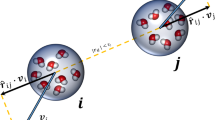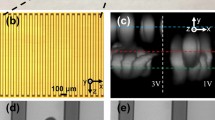Abstract
Electrokinetics manipulation and separation of living cells employing microfluidic devices require good knowledge of the strength and distribution of electric field in such devices. AC dielectrophoresis is performed by generating non-uniform electric field using microsize electrodes. Among the several applications of dielectrophoretic phenomenon, this present study considers the recently introduced phenomenon of moving dielectrophoresis. An analytical solution using Fourier series is presented for the electric field distribution and dielectrophoretic force generated inside a microchannel. The potential at the upper part of the microchannel has been found by solving the governing equation of the electric potential with specific boundary conditions. The solutions for the electric field and dielectrophoretic force show excellent agreement with the numerical results. Microdevices were fabricated and experiments were carried out with living cells confirming and validating the analytical solutions.











Similar content being viewed by others
References
Chang DE, Loire S et al (2003) Closed-form solutions in the electrical field analysis. J Phys D Appl Phys 36:3073–3078
Chen DF, Du H et al (2005) Numerical modeling of dielectrophoresis using a meshless approach. J Micromech Microeng 15:1040–1048
Clague DS, Wheeler EK (2001) Dielectrophoretic manipulation of macromolecules: the electric field. Phys Rev E 64(2):26605
Doh I, Cho YH (2005) A continuous cell separation chip using hydrodynamic dielectrophoresis (DEP) process. Sens Actuators A 121(1):59–65
Gascoyne PRC, Vykoukal J (2002) Particle separation by dielectrophoresis. Electrophoresis 23(13):1973–1983
Gascoyne PRC, Wang XB et al (1997) Dielectrophoretic separation of cancer cells from blood. IEEE Trans Ind Appl 33(3):670–678
Green NG, Ramos A et al (2002) Numerical solution of the dielectrophoretic and travelling wave forces for interdigitated electrode arrays using the finite element method. J Electrostat 56(2):235–254
Holmes D, Green NG et al (2003) Microdevices for dielectrophoretic flow-through cell separation. Eng Med Biol Mag, IEEE 22(6):85–90
Huang Y, Holzel RP (1992) Differences in the AC electrodynamics of viable and non-viable yeast cells determined through combined dielectrophoresis and electrorotation studies. Phys Med Biol 37(7):1499–1517
Huang Y, Joo S et al (1997) Dielectrophoretic cell separation and gene expression profiling on microelectronic chip arrays. Biochim Biophys Acta 1323:240–252
Kua CH, Lam YC et al (2007) Dynamic cell fractionation and transportation using moving dielectrophoresis. Anal Chem 79:6975–6987
Kua CH, Lam YC et al (2008a) Cell motion model for moving dielectrophoresis. Anal Chem 80:5454–5461
Kua CH, Lam YC et al (2008b) Modeling of dielectrophoretic force for moving dielectrophoresis electrodes. J Electrostat 66:514–525
Li H, Bashir R (2002) Dielectrophoretic separation and manipulation of live and heat-treated cells of Listeria on microfabricated devices with interdigitated electrodes. Sens Actuators B 86(2–3):215–221
Markx GH, Huang Y et al (1994) Dielectrophoretic characterization and separation of micro-organisms. Microbiology 140(3):585–591
Morgan H, Izquierdo AG et al (2001a) The dielectrophoretic and travelling wave forces generated by interdigitated electrode arrays: analytical solution using Fourier series. J Phys D Appl Phys 34(10):1553–1561
Morgan H, Izquierdo AG et al (2001b) The dielectrophoretic and travelling wave forces for interdigitated electrode arrays: analytical solution using Fourier series. J Phys D Appl Phys 34:1553–1561
Multiphysics C (2006) COMSOL Multiphysics
Pethig R, Markx GH (1997) Applications of dielectrophoresis in biotechnology. Trends Biotechnol 15(10):426–432
Pethig R, Wang XB et al (1992) Positive and negative dielectrophoretic collection of colloidal particles using interdigitated castellated microelectrodes. J Phys D Appl Phys 25:881–888
Pohl HA (1978) Dielectrophoresis: the behavior of neutral matter in nonuniform electric fields. Cambridge University Press, Cambridge; New York
Sun T, Morgan H et al (2007) Analytical solutions of Ac electrokinetics in interdigitated electrode arrays: electric field, dielectrophoretic and traveling-wave dielectrophoretic forces. Phys Rev E 76(4):1–18
Sun T, Morgan H et al (2008) Analytical solutions of the dielectrophoretic and travelling wave forces generated by interdigitated electrode arrays. The 12th international conference on electrostatics. Institute of Physics Publishing, Oxford, UK
Wang X, Wang XB et al (1996) A theoretical method of electrical field analysis for dielectrophoretic electrode arrays using Green’s theorem. J Phys D Appl Phys 29:1649–1660
Wang XB, Yang J et al (2000) Cell separation by dielectrophoretic field-flow-fractionation. Anal Chem 72(4):832–839
Author information
Authors and Affiliations
Corresponding author
Rights and permissions
About this article
Cite this article
Alazzam, A., Roman, D., Nerguizian, V. et al. Analytical formulation of electric field and dielectrophoretic force for moving dielectrophoresis using Fourier series. Microfluid Nanofluid 9, 1115–1124 (2010). https://doi.org/10.1007/s10404-010-0632-1
Received:
Accepted:
Published:
Issue Date:
DOI: https://doi.org/10.1007/s10404-010-0632-1




